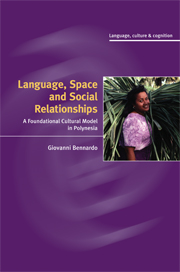Book contents
- Frontmatter
- Contents
- List of figures
- List of tables
- Preface
- Acknowledgments
- List of abbreviations
- 1 A foundational cultural model in Tongan language, culture, and social relationships
- 2 The Kingdom of Tonga: country, people, and language
- Part I Space in Tongan language, culture, and cognition
- Part II Radiality
- 6 The radiality hypothesis
- 7 Radiality in possession and time
- 8 Radiality and the Tongan kinship terminology
- Part III Radiality in social relationships
- References
- Author Index
- Subject Index
6 - The radiality hypothesis
from Part II - Radiality
Published online by Cambridge University Press: 19 August 2009
- Frontmatter
- Contents
- List of figures
- List of tables
- Preface
- Acknowledgments
- List of abbreviations
- 1 A foundational cultural model in Tongan language, culture, and social relationships
- 2 The Kingdom of Tonga: country, people, and language
- Part I Space in Tongan language, culture, and cognition
- Part II Radiality
- 6 The radiality hypothesis
- 7 Radiality in possession and time
- 8 Radiality and the Tongan kinship terminology
- Part III Radiality in social relationships
- References
- Author Index
- Subject Index
Summary
Radiality
What is radiality? In its most abstract form, radiality is a structural organization in which a number of vectors share a common origin that may also function as an ending point for all these vectors. In spatial relationships, radiality is the relationship between two points where one of them functions as the origin or goal of the vector that signals the relationship. This origin/goal remains constant over a number of relationships with any number of points. The origin/goal can be ego, i.e., cognizer, viewer, and/or speaker, or a point in the field of ego. I decided to label ‘radiality’ this latter specific case; that is, a point in the field of ego, i.e., other-than-ego, is chosen to function as the source/goal of a number of relationships with other points in the same field, including ego. Essentially, this type of radiality stands for a foregrounding of other-than-ego while at the same time ego is relegated to the background (Figure 6.1).
This minimal structural organization, a cognitive ‘molecule,’ is fundamental to human cognition and can be found in a variety of knowledge domains within and across linguistic and cultural boundaries. Why, then, focus on it? Because, I am convinced that in Tongan cognition this ‘molecule’ plays a fundamental role in the generation and organization of a variety of knowledge domains.
Information
- Type
- Chapter
- Information
- Language, Space, and Social RelationshipsA Foundational Cultural Model in Polynesia, pp. 173 - 190Publisher: Cambridge University PressPrint publication year: 2009
